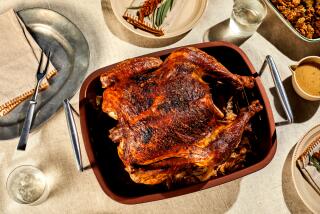Advice From a Master Carver
- Share via
Most of us cook whole turkeys only a few times each year, which means that every year, when it’s time to serve the turkey, we find we’ve forgotten the basic carving techniques. Klaus J. Kopf, executive chef for The Times Mirror Co., demonstrated the method he uses for carving the numerous birds served in the company’s dining rooms.
Avoid overcooking the turkey or the meat will crumble when it’s sliced. Also remember that after removing the bird from the oven, allow it to stand at room temperature 20 to 30 minutes so the juices set and the meat firms.
Kopf uses a chef’s knife to remove the legs and thighs, then switches to a very sharp carving knife for slicing the breast meat--the sharper the blade, the more attractive the slices. A serrated knife should not be used because it tends to tear the meat.
To remove the drumstick and thigh, press the leg away from the body. The joint connecting the leg to the backbone will often snap free, but if it doesn’t, it may be severed with the point of a knife (Step 1).
Cut the thigh from the body by following the contour carefully with the knife (Step 2). Place on a separate plate, then cut through the connecting joint between the leg and thigh.
Tilt the drumstick to a convenient angle and slice the meat away in a downward motion (Step 3) toward the plate. Hold the thigh firmly on the plate with a fork and cut into even slices parallel to the bone.
The wings are typically left in place to keep the bird stable while the breast meat is carved in downward slices, across the grain (Step 4). Begin each new slice slightly higher up on the breast, keeping the slices thin and even.
Inexperienced carvers may find it easier to tackle the bird in the kitchen rather than at the dining table. The sliced meat may then be arranged on a platter for serving.
After the feast and back in the kitchen, a boning knife can be used to remove the rest of the meat from the carcass. Package everything well and refrigerate or freeze for later use.
More to Read
Eat your way across L.A.
Get our weekly Tasting Notes newsletter for reviews, news and more.
You may occasionally receive promotional content from the Los Angeles Times.









